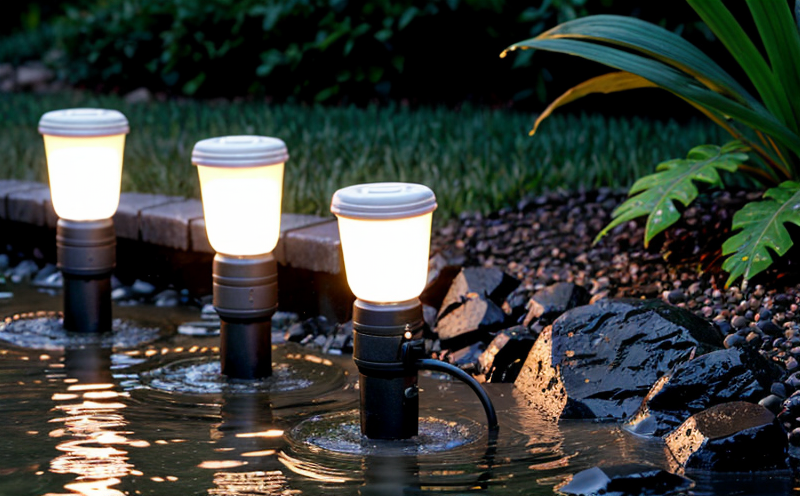Testing the ability of lighting devices to withstand exposure to water and moisture.
Testing the Ability of Lighting Devices to Withstand Exposure to Water and Moisture A Crucial Service for Businesses
In todays competitive market, businesses must ensure that their products can withstand various environmental conditions to maintain customer satisfaction and regulatory compliance. One critical aspect of product testing is evaluating a devices ability to withstand exposure to water and moisture. This laboratory service, offered by Eurolab, is essential for manufacturers of lighting devices, including LED bulbs, lamps, and fixtures.
What is Testing the Ability of Lighting Devices to Withstand Exposure to Water and Moisture?
This laboratory service involves subjecting lighting devices to controlled levels of water or moisture to assess their performance under adverse conditions. The primary objective is to evaluate a devices ability to function safely and efficiently in humid environments, such as bathrooms, kitchens, or outdoor areas.
Why is it Essential for Businesses?
Conducting testing for exposure to water and moisture ensures that lighting devices meet regulatory requirements and consumer expectations. Failure to do so can lead to
Product recalls due to safety concerns
Loss of business reputation and customer trust
Compliance issues with international standards (e.g., IEC 60598, UL 1598)
Decreased product lifespan and increased maintenance costs
Advantages of Using Eurolabs Testing Service
Here are the key benefits of partnering with Eurolab for testing your lighting devices
Improved Product Reliability Comprehensive testing ensures that products can withstand various environmental conditions, reducing the likelihood of failures or malfunctions.
Enhanced Customer Satisfaction By guaranteeing product performance in humid environments, businesses can maintain customer trust and satisfaction.
Compliance with Regulatory Requirements Eurolabs testing services ensure compliance with international standards (e.g., IEC 60598, UL 1598), reducing the risk of product recalls or regulatory penalties.
Cost Savings Identifying potential issues early on through testing reduces the likelihood of costly repairs or replacements down the line.
Increased Efficiency By identifying areas for improvement, businesses can optimize their manufacturing processes and reduce production costs.
How Does Eurolabs Testing Process Work?
Our team of experts follows a rigorous process to ensure accurate and reliable results
Test Plan Development Our experts work with clients to develop a customized test plan tailored to their specific requirements.
Equipment Calibration All testing equipment is calibrated to international standards (e.g., IEC 60598, UL 1598) to ensure accuracy and reliability.
Testing Procedures Lighting devices are subjected to controlled levels of water or moisture using specialized equipment, such as climate chambers or immersion baths.
Data Analysis and Reporting Results are analyzed, and detailed reports are provided to clients, including recommendations for product improvement.
QA Section
Weve compiled a list of frequently asked questions to help you better understand the testing process
Q What types of lighting devices can be tested?
A Eurolabs testing service is applicable to various lighting devices, including LED bulbs, lamps, and fixtures.
Q How long does the testing process typically take?
A The duration of testing varies depending on the specific requirements, but our team works efficiently to ensure timely results.
Q Can you test for other environmental conditions, such as temperature or vibration?
A Yes, Eurolab offers a range of testing services for various environmental conditions. Please consult with our experts for more information.
Q How do I prepare my products for testing?
A We provide detailed guidelines and instructions on preparing your products for testing to ensure accurate results.
Conclusion
Testing the ability of lighting devices to withstand exposure to water and moisture is a critical aspect of product development. By partnering with Eurolab, businesses can ensure compliance with regulatory requirements, improve product reliability, and enhance customer satisfaction. Our team of experts provides comprehensive testing services tailored to your specific needs, helping you navigate the complexities of product testing with confidence.
If youre ready to take your product testing to the next level, contact us today to learn more about our services.
-
Verifying the ingress protection (IP) rating of lighting devices against dust and water penetration.
-
Performing water resistance tests to evaluate lighting devices' suitability for outdoor or wet environments.
-
Ensuring that lighting devices are protected against rain, splashes, and immersion under specific conditions.
-
Testing for water resistance across various sealing mechanisms and enclosures.
-
Assessing the impact of water exposure on the electrical components of lighting devices.
-
Testing the ingress of dust and moisture into lighting fixtures through mechanical openings.
-
Ensuring lighting devices meet IP ratings for use in bathrooms, kitchens, and outdoor settings.
-
Evaluating waterproof performance in extreme conditions, such as heavy rain or submersion in water.
-
Testing for the resistance of lighting devices to saltwater exposure in coastal environments.
-
Assessing the durability of seals and gaskets used to prevent water ingress in outdoor lighting devices.
-
Testing lighting systems for immersion in water for extended periods (e.g., submersible lights).
-
Testing the waterproofing features of lighting systems with integrated smart features (e.g., wireless control).
-
Ensuring compliance with industry standards for IP ratings in residential, commercial, and industrial lighting.
-
Performing pressure testing to simulate water column depth and test waterproof performance.
-
Verifying the effectiveness of waterproofing for solar-powered lighting systems used outdoors.
-
Testing for waterproof performance of lighting systems used in marine and aquatic environments.
-
Ensuring that lighting products meet international standards such as IP65, IP67, or IP68 for water resistance.
-
Testing for water resistance in both new products and over extended product lifecycles.
-
Evaluating the effectiveness of corrosion-resistant materials used to enhance waterproofing.
-
Assessing the reliability of waterproof lighting devices in extreme outdoor weather conditions.
-
Ensuring that waterproof lighting systems perform efficiently in temperature variations and humidity.
-
Testing for any reduction in light output or fixture integrity due to water exposure.




